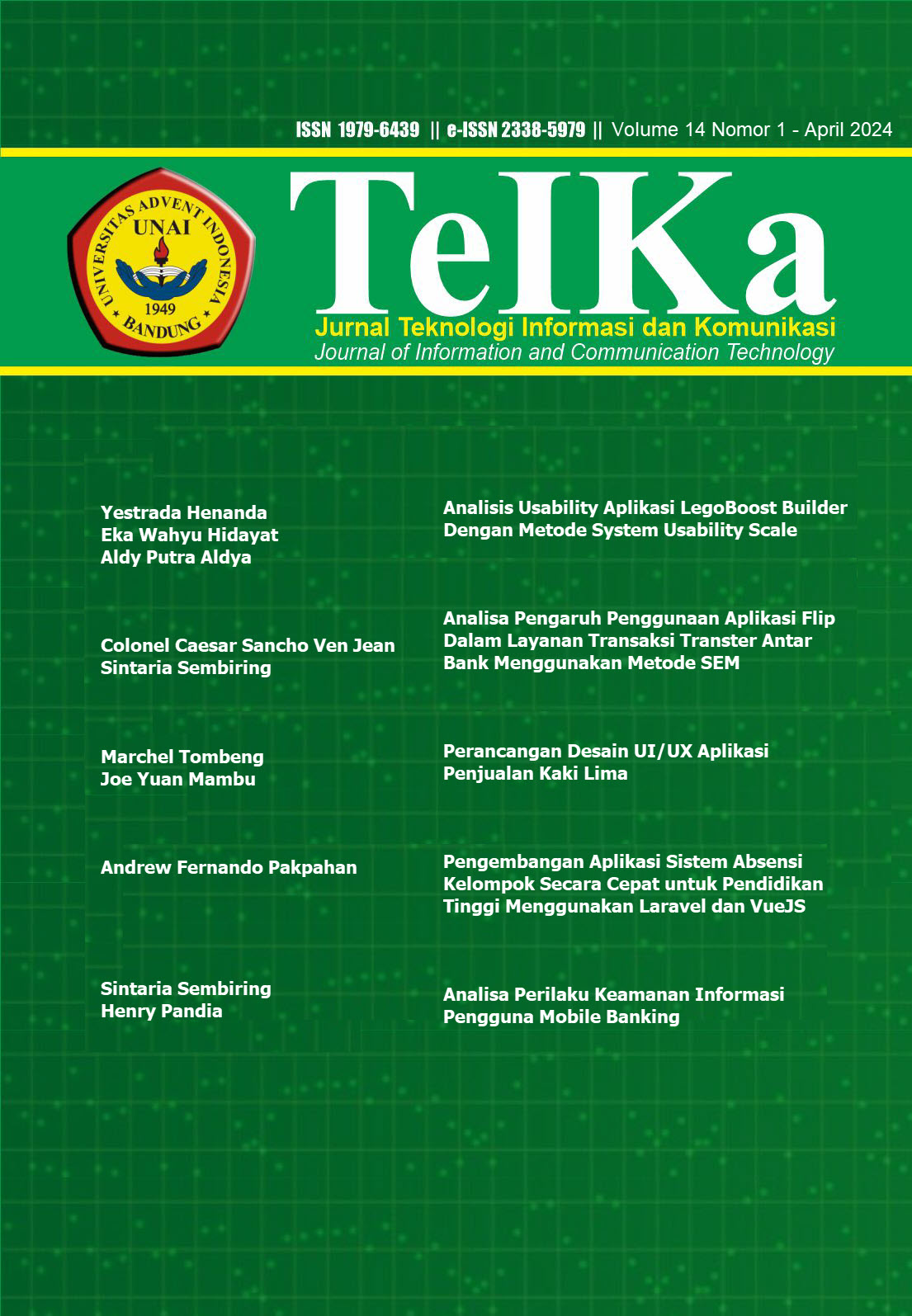Pengembangan Aplikasi Sistem Absensi Kelompok Secara Cepat untuk Pendidikan Tinggi Menggunakan Laravel dan VueJS
Kata Kunci:
Sistem Absensi, Rapid Application, Aplikasi Web, Laravel, VueJSAbstrak
Penelitian ini menyajikan pengembangan Sistem Absensi Kelompok untuk institusi pendidikan tinggi menggunakan kerangka kerja Laravel dan VueJS. Sistem ini mengatasi keterbatasan metode pencatatan kehadiran tradisional dengan menawarkan solusi berbasis web yang dioptimalkan untuk perangkat mobile. Menggunakan metodologi Rapid Application Development (RAD), penelitian ini menguraikan proses desain dan implementasi, termasuk pembuatan antarmuka yang ramah pengguna untuk administrator dan koordinator mahasiswa. Aplikasi ini memfasilitasi pengelolaan kelompok mahasiswa secara efisien, penjadwalan pertemuan, dan pencatatan kehadiran secara real-time. Pengujian blackbox yang komprehensif memvalidasi fungsionalitas sistem di berbagai area penting seperti autentikasi pengguna, pendaftaran mahasiswa, dan pencatatan kehadiran. Hasil penelitian menunjukkan peningkatan signifikan dalam efisiensi, akurasi, dan aksesibilitas manajemen kehadiran, berkontribusi pada kemajuan solusi digital dalam administrasi pendidikan.
Unduhan
Referensi
J. Panjaitan and A. Pakpahan, “Perancangan Sistem Absensi Care Group Mahasiswa Berbasis Web Menggunakan Metode Agile Development (Studi Kasus: Universitas Advent Indonesia),” CogITo Smart J., vol. 8, no. 2, pp. 321–334, 2022.
N. S. Ali, A. H. Alhilali, H. D. Rjeib, H. Alsharqi, and B. Al-Sadawi, “Automated attendance management systems: systematic literature review,” Int J Technol Enhanc Learn, vol. 14, no. 1, pp. 37–65, Jan. 2022, doi: 10.1504/ijtel.2022.120559.
A. Haleem, M. Javaid, M. A. Qadri, and R. Suman, “Understanding the role of digital technologies in education: A review,” Sustain. Oper. Comput., vol. 3, pp. 275–285, Jan. 2022, doi: 10.1016/j.susoc.2022.05.004.
K. O. Simatupang and A. F. Pakpahan, “Metode Agile Dalam Perancangan Sistem Informasi Reservasi Fasilitas Universitas Advent Indonesia,” J. Inf. Syst. Res. JOSH, vol. 3, no. 4, pp. 608–617, 2022.
A. M. McCarthy, D. Maor, A. McConney, and C. Cavanaugh, “Digital transformation in education: Critical components for leaders of system change,” Soc. Sci. Humanit. Open, vol. 8, no. 1, p. 100479, Jan. 2023, doi: 10.1016/j.ssaho.2023.100479.
A. F. Pakpahan, “Design of End-to-end Student Research Administration Application using Rapid Prototyping Method in Universitas Advent Indonesia,” 8ISC Proc. Technol., pp. 25–32, 2022.
E. S. Soegoto, “Implementing Laravel framework website as brand image in higher-education institution,” IOP Conf. Ser. Mater. Sci. Eng., vol. 407, no. 1, p. 012066, Aug. 2018, doi: 10.1088/1757-899X/407/1/012066.
Darwin C. Mangca, “Enhanced Attendance Monitoring: Utilizing QR Code for Online Attendance with Laravel Framework and SMS Notification,” Int. J. Adv. Res. Sci. Commun. Technol., pp. 237–243, Jul. 2023, doi: 10.48175/IJARSCT-12133.
M. Nugraha, R. Agus, H. Fathi, and R. Baginda, “DEVELOPMENT A WEB-BASED STUDENT INTERNSHIP APPLICATION USING LARAVEL FRAMEWORK,” J. Inf. Technol. Its Util., vol. 6, no. 1, Art. no. 1, Jul. 2023, doi: 10.56873/jitu.6.1.5139.
S. Arifin, A. Asroni, and A. Kurniawati, “Development of a Web-Based School Payment Administration Information System Using the Laravel Framework,” Emerg. Inf. Sci. Technol., vol. 2, no. 1, Art. no. 1, 2021, doi: 10.18196/eist.v2i1.16857.
A. F. Ibrahim, N. Musa, and M. N. F. Jamaludin, “Internship Application System (IAS) for University Students using Laravel,” J. Comput. Res. Innov., vol. 3, no. 4, Art. no. 4, Nov. 2018, doi: 10.24191/jcrinn.v3i4.85.
H. Susanto, V. S. Syavitri, D. Yanto, and Karyono, “Design a Web-based Education Development Contribution Payment Application at SDIT Tahfidz Bintangku,” Bit-Tech, vol. 6, no. 1, Art. no. 1, Aug. 2023, doi: 10.32877/bt.v6i1.865.
A. R. E. Najaf, J. D. Alexander, K. Tarmidzi, and F. Kurnia, “DESIGNING A WEB-BASED ELEMENTARY SCHOOL ATTENDANCE SYSTEM USING THE LARAVEL FRAMEWORK,” RIGGS J. Artif. Intell. Digit. Bus., vol. 1, no. 2, Art. no. 2, Jan. 2023, doi: 10.31004/riggs.v1i2.116.
Ghandi B. Galila, “Student Ticketing using Laravel Framework,” Int. J. Adv. Res. Sci. Commun. Technol., pp. 612–617, Jul. 2023, doi: 10.48175/IJARSCT-12186.
A. F. Pakpahan, Dasar-Dasar Pengembangan Aplikasi Web Modern dengan Framework Laravel. Media Sains Indonesia, 2020.
L. Lohr, M. Javeri, C. Mahoney, J. Gall, K. Li, and D. Strongin, “Using rapid application development to improve the usability of a preservice teacher technology course,” Educ. Technol. Res. Dev., vol. 51, no. 2, pp. 41–55, Jun. 2003, doi: 10.1007/BF02504525.
Y. Fadhillah, “IMPLEMENTASI RAPID APPLICATION DEVELOPMENT SISTEM INFORMASI PENDIDIKAN SMA DALAM MENGHADAPI INDUSTRI 4.0,” J. Ris. Inform., vol. 1, no. 2, Art. no. 2, Mar. 2019.
M. L. da Silva, H. Silva, and D. Gonçalves, “Rapid Application Development to Create Proof-of-Concept Software Applications,” presented at the International Conference on Physiological Computing Systems, Jun. 2024, pp. 299–306. Accessed: Jun. 24, 2024. [Online]. Available: https://www.scitepress.org/Link.aspx?doi=10.5220/0004698202990306
R. Trimahardhika and E. Sutinah, “Penggunaan Metode Rapid Application Development Dalam Perancangan Sistem Informasi Perpustakaan,” J. Inform., vol. 4, no. 2, Art. no. 2, Sep. 2017, doi: 10.31294/ji.v4i2.2226.
B. Prashanth Kumar and Y. Prashanth, “Improving the Rapid Application Development process model,” in 2014 Conference on IT in Business, Industry and Government (CSIBIG), Mar. 2014, pp. 1–3. doi: 10.1109/CSIBIG.2014.7056962.
J. Martin, Rapid Application Development. New York : Toronto : New York: Macmillan Coll Div, 1991.
##submission.downloads##
Diterbitkan
Cara Mengutip
Terbitan
Bagian
Lisensi
Hak Cipta (c) 2024 TeIKa

Artikel ini berlisensiCreative Commons Attribution-ShareAlike 4.0 International License.
The submitting author warrants that the submission is original and that she/he is the author of the submission together with the named co-authors; to the extend the submission incorporates text passages, figures, data or other material from the work of others, the submitting author has obtained any necessary permission.
Articles in this journal are published under the Creative Commons Share Alike Attribution Licence (CC-BY-SA What does this mean?). This is to get more legal certainty about what readers can do with published articles, and thus a wider dissemination and archiving, which in turn makes publishing with this journal more valuable for you, the authors.
By submitting an article the author grants to this journal the non-exclusive right to publish it. The author retains the copyright and the publishing rights for his article without any restrictions.










